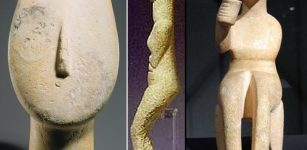Caganer: The Pooping Man Is Part Of The Catalonian Christmas Tradition And Nativity Scene
Ellen Lloyd - AncientPages.com - Most of us would think twice before placing this little pooping guy known as Caganer at home during Christmas. Our friends and family might think we have an odd sense of humor and there seems to be nothing Christian about him at all.
The situation and views are completely different in Catalonia. This can be surprising to some, but Caganer, the pooping man is accepted by the Catholic Church in Catalonia within the areas where the Caganer is popular.
Caganer. Credit: istolethetv - CC BY 2.0 - Right: A Caganer figurine in Barcelona, Spain. Credit: Roeland P. - CC BY 2.0
Caganer is a respected Christmas figure one can find him in all homes in Catalonia. He is a part of the Catalonian Christmas tradition and has been so for a very long time.
The exact origin of the Caganer is unknown, but the tradition has existed since at least the 18th century.
Most people in Catalonia have no idea how Caganer became part of the Christmas tradition, but each house buys a figure every year.
For at least the past two centuries, the traditional nativity scene in Catalonia has been enhanced by a Caganer. The Caganer is never in the front of the nativity scene. That would be a lack of respect. He is often hiding in a corner doing his business whilst the birth of Christ. The name "El Caganer” literally means "the crapper" or "the shitter".
A polite translation of El Caganer would be The Defecator and he is normally dressed in the traditional Catalan peasant clothing of a white shirt, black trousers, and a red faixa and barretina and is often smoking a pipe.
Why Is A Pooping Man Part Of The Nativity Scene?
Originally, El Caganer wasn't a figure in the nativity scene. He was only depicted on tiles, but from the 19th century onward he became popular as a nativity character.
How he entered the nativity scene is uncertain, but according to one theory, this has to do with the fact that Catalans traditionally referred to newborn babies as caganers because they do little else other than eat, sleep and defecate.
Consequently, when visitors came around at Christmas, they would look at the nativity scene and ask their hosts "Have you put in the caganer yet?" referring to the baby Jesus.
Credit: Caganercom - CC BY-SA 3.0
At some point, an imaginative manufacturer of nativity figures must have decided to turn the title character into a nativity model and so the tradition of El Caganer was born.
Another explanation is that El Caganer fertilizes the ground with his feces and so is considered a symbol of prosperity and good luck for the coming year.
There is a legend that if a countryside man did not put a caganer in the nativity scene, he would have a very bad year collecting vegetables,” he said, claiming that the figurine is a symbol of fertility and good fortune.
Attempts To Ban The Caganer Failed
There were some attempts by the government to remove the Caganer from public nativities. In 2005 the local council of Barcelona decided to omit the Caganer from the city’s public nativity scene, it was said the presence of Caganer encouraged bad behavior in a city which has struggled with problems of public urination in the past.
People didn’t like this decision at all and many locals complained about what they saw as an attack on their cultural heritage. In 2006 the caganer was reinstated to his usual place among the wise men, the donkeys, and the angels. It seems that, despite his unverified origins and dubious behavior, the Caganer is more popular than ever and he is definitely here to stay.
Credit: Caganercom - CC BY-SA 3.0
In recent years, it’s possible to buy a Caganer made in the image of a public figure. Christmas markets sell the likes of politicians, soccer players, foreign presidents, rock stars, and royalty.
Needless to say that people find this funny and figures like for example Queen Elizabeth II are popular, but if you don’t want the queen, you can always buy someone else.
Updated on December 15, 2021
Written by Ellen Lloyd – AncientPages.com
Copyright © AncientPages.com All rights reserved. This material may not be published, broadcast, rewritten or redistributed in whole or part without the express written permission of AncientPages.com
Expand for referencesMore From Ancient Pages
-
 What Happened To The Mysterious And Beautiful Queen Nefertiti?
Featured Stories | Apr 4, 2017
What Happened To The Mysterious And Beautiful Queen Nefertiti?
Featured Stories | Apr 4, 2017 -
 Mystery Of Ancient Symbols On A 2,700-Year-Old Temple In Khorsabad, Iraq – Solved
Archaeology | May 3, 2024
Mystery Of Ancient Symbols On A 2,700-Year-Old Temple In Khorsabad, Iraq – Solved
Archaeology | May 3, 2024 -
 Advanced Ancient Technology – Talos A Greek Robot Created By The God Of The Forge
Featured Stories | Jun 28, 2014
Advanced Ancient Technology – Talos A Greek Robot Created By The God Of The Forge
Featured Stories | Jun 28, 2014 -
 In Ancient California Matriarchal Society, Daughters Breastfed Longer And Women Accumulated Greater Wealth
Archaeology | Jul 13, 2023
In Ancient California Matriarchal Society, Daughters Breastfed Longer And Women Accumulated Greater Wealth
Archaeology | Jul 13, 2023 -
 Unique Medieval Spindle Whorl With Cyrillic Inscription Discovered In Poland
Archaeology | Mar 9, 2018
Unique Medieval Spindle Whorl With Cyrillic Inscription Discovered In Poland
Archaeology | Mar 9, 2018 -
 On This Day In History: ‘Sea King’ Ragnar Lodbrok Seizes Paris – On March 28, 845
Featured Stories | Mar 28, 2016
On This Day In History: ‘Sea King’ Ragnar Lodbrok Seizes Paris – On March 28, 845
Featured Stories | Mar 28, 2016 -
 Nebiri, a ‘Chief of Stables’ – oldest case of heart disease in 3,500-year-old mummy
News | Aug 28, 2015
Nebiri, a ‘Chief of Stables’ – oldest case of heart disease in 3,500-year-old mummy
News | Aug 28, 2015 -
 Glorious And Scary Orava Castle – Realms Of Nosferatu And A Historical Landmark Of Slovakia
Featured Stories | Jan 24, 2020
Glorious And Scary Orava Castle – Realms Of Nosferatu And A Historical Landmark Of Slovakia
Featured Stories | Jan 24, 2020 -
 William Adams: The Journey To Becoming The First White Samurai
Featured Stories | Jul 11, 2018
William Adams: The Journey To Becoming The First White Samurai
Featured Stories | Jul 11, 2018 -
 Unexplained Phenomena In Arkansas – Old Mysteries Still Puzzling The Modern World
Featured Stories | Jan 9, 2019
Unexplained Phenomena In Arkansas – Old Mysteries Still Puzzling The Modern World
Featured Stories | Jan 9, 2019 -
 Who Is Buried In The Extremely Well-Preserved 2,600-Year-Old Celtic Chamber Tomb Found Near Riedlingen, Germany?
Archaeology | Oct 24, 2024
Who Is Buried In The Extremely Well-Preserved 2,600-Year-Old Celtic Chamber Tomb Found Near Riedlingen, Germany?
Archaeology | Oct 24, 2024 -
 Unusual Discovery Of A Viking Age Phallic Stone In Tystberga, Sweden
Archaeology | Jun 12, 2023
Unusual Discovery Of A Viking Age Phallic Stone In Tystberga, Sweden
Archaeology | Jun 12, 2023 -
 The Cyclades And Their Mysterious Society Lost In Time
Civilizations | Feb 4, 2016
The Cyclades And Their Mysterious Society Lost In Time
Civilizations | Feb 4, 2016 -
 New DNA Evidence Rewrites Ancient History Of Pompeii
DNA | Nov 8, 2024
New DNA Evidence Rewrites Ancient History Of Pompeii
DNA | Nov 8, 2024 -
 Forbidden Ancient Manuscripts Almost Erased From History – Unusual Myths, Beliefs And Practices – Part 2
Artifacts | May 11, 2018
Forbidden Ancient Manuscripts Almost Erased From History – Unusual Myths, Beliefs And Practices – Part 2
Artifacts | May 11, 2018 -
 Eye Of Horus – Powerful, Ancient Egyptian Symbol With Deep Meaning
Ancient Symbols | Jan 21, 2019
Eye Of Horus – Powerful, Ancient Egyptian Symbol With Deep Meaning
Ancient Symbols | Jan 21, 2019 -
 On This Day In History: The Battle of Mortimer’s Cross – On Feb 2, 1461
News | Feb 2, 2017
On This Day In History: The Battle of Mortimer’s Cross – On Feb 2, 1461
News | Feb 2, 2017 -
 Metal Artifacts In Southeast Asia Archaeological Theory – Challenged
Archaeology | Jul 31, 2021
Metal Artifacts In Southeast Asia Archaeological Theory – Challenged
Archaeology | Jul 31, 2021 -
 Thousands Of Remarkable Megaliths On The Sumba Island
Featured Stories | Aug 30, 2017
Thousands Of Remarkable Megaliths On The Sumba Island
Featured Stories | Aug 30, 2017 -
 Florida’s Windover Bog Bodies Predate The Egyptian Pyramids And Can Rewrite Ancient American History
Featured Stories | Jun 3, 2021
Florida’s Windover Bog Bodies Predate The Egyptian Pyramids And Can Rewrite Ancient American History
Featured Stories | Jun 3, 2021



